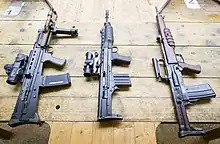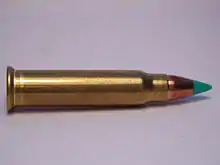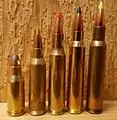4.85×49mm
The 4.85×49mm is an experimental intermediate firearm cartridge made by the United Kingdom for the Individual Weapon Project, which became the SA80 series of small arms.
| 4.85×49mm | ||||||||
|---|---|---|---|---|---|---|---|---|
 | ||||||||
| Type | Rifle | |||||||
| Place of origin | United Kingdom | |||||||
| Production history | ||||||||
| Designer | Royal Small Arms Factory | |||||||
| Specifications | ||||||||
| Parent case | 5.56×45mm NATO | |||||||
| Case type | Rimless, bottleneck | |||||||
| Bullet diameter | .197 in (5.0 mm) | |||||||
| Neck diameter | .220 in (5.6 mm) | |||||||
| Shoulder diameter | .353 in (9.0 mm) | |||||||
| Base diameter | .375 in (9.5 mm) | |||||||
| Rim diameter | .376 in (9.6 mm) | |||||||
| Rim thickness | .041 in (1.0 mm) | |||||||
| Case length | 1.925 in (48.9 mm) | |||||||
| Overall length | 2.455 in (62.4 mm) | |||||||
| Primer type | Small rifle | |||||||
| Maximum pressure | 52,000 psi | |||||||
| Ballistic performance | ||||||||
| ||||||||
| Test barrel length: N/A Source(s): Ammo Encyclopedia[1] | ||||||||
Design
The 4.85×49mm cartridge is based on the 5.56×45mm NATO, but uses a 5 mm bullet and has a longer neck than the 5.56mm does. Muzzle velocity is better than the M193 5.56mm loading, which this cartridge was designed to compete against. The 4.85×49mm cartridge weighs 11.62 grams (179.3 gr).
History
During the 1960s, the United Kingdom experimented with creating a lightweight but effective replacement for the 7.62×51mm NATO round. Their original experiments focused on a .280 British round necked down to 6.3 mm.[2] However, in the 1960s, a West German study proposed that an ideal cartridge would have a 5 mm or smaller calibre. The results of this study encouraged the United Kingdom switch to using a 5 mm calibre bullet for their experimental cartridge.[3] The requirement for a 5 mm round for what would be the SA80 sealed the idea that a 5 mm round needed to be made.
The 4.85×49mm started off as the 5×44mm round, which was made in 1970.[3][4] The bullet shape used in these early prototypes was based on one used by the 6.23×43mm round, another experimental British round.[4] The actual cases were made from reformed 5.56 NATO rounds. However, it was soon decided that the round would be renamed the "4.85×44mm" in order to match the diameter of the test gun barrel's lands.[3] The actual diameter of the round did not change.

Continued tests showed that there were problems with bullet seating. To fix this, the round's neck was elongated 5 mm to create a 4.85×49mm round. However, before the production lines were fully retooled for the new round, RSAF Enfield required a batch of ammo for testing. Existing 4.85×44mm rounds had their necks manually stretched out 5 mm in order to qualify for the test.[3]
Tests with both the 4.85×49mm round and the L64/65 continued throughout the 1970s. In 1976, the L64/L65 weapon system was officially announced.[5] In 1977, trials to find a new cartridge and weapon for NATO standardisation were underway. The United Kingdom submitted the IW weapon a 4.85×49mm. Lots of both the XL1E1 ball and XL2E1 tracer round were created in order to provide enough ammunition for the tests. The UK hoped that the United States and NATO would see the inherent advantages the 4.85×49mm round had over the 5.56×45mm NATO round and adopt it.[5]
The 4.85mm's lifespan came to an end when the ending results of the NATO tests concluded that the FN Herstal SS109 bullet for the 5.56mm had the best performance. In 1979, British testers formally scrapped the 4.85 mm round in favour of the 5.56 mm round.[6] The IW system was subsequently rechambered to 5.56 mm.
No other countries have used the 4.85 mm round.
Variants
Several variants of the 4.85 mm round were made over its lifetime.
Ball
The most common type of 4.85 mm round is the XL1E1 ball, which was used in NATO trials.[4] This round has a 55.3 grain bullet that has a muzzle velocity of 3,115 ft/s and a muzzle energy of 1,210 ft/lbf.
Tracer
Several tracer types were made for the 4.85mm, but the most common one is the XL2E1, which was used in NATO trials.[4] It has an orange tipped head. Up to ten other variants were produced, but never made it into full production.
Short Range
A 4.85 mm variant designed for short range used the same case that the standard round used, but fired a round and white plastic bullet.
Dummy
Several dummies were produced for the 4.85mm during its lifetime. Early dummies were simply a blank 4.85×44mm round with a 5 mm longer neck, but later models include a round with three holes drilled in its base, and a chrome-plated case that has several vertical flutes on it.
A special plastic training dummy version of the 4.85mm was also made. it consisted of a sawed-off 4.85mm cartridge with a blue plastic head on it.[4] When the gun is fired, the plastic head flies off.
Blanks
Early blanks were made out of, but later ones used a standard-shaped cartridge with a rosecrimp blank shape where the head would be. The rosecrimp blank was also used for blanks used to fire rifle grenades.
Armour piercing
Armour-piercing rounds were developed for both the 4.85×44mm and 4.85×49mm rounds, but never went into large-scale production, like the ball and tracer variants had.[4] The AP rounds have a black band just under the bullet tip.
Gallery
 Xl1E1 ball cartridge on left and XL2E1 tracer round on the right
Xl1E1 ball cartridge on left and XL2E1 tracer round on the right XL1E1 cartridge on the left and a .223 Remington cartridge on the right
XL1E1 cartridge on the left and a .223 Remington cartridge on the right
See also
References
- Bussard, Mike (2011). Ammo Encyclopedia 2nd Edition. Minneapolis, MN: Blue Book Publications, Inc. p. 498. ISBN 978-1-936120-01-7.
- "The 6.25x43mm". Retrieved 2012-09-26.
- "The 5x56x45mm timeline: 1970–1973". Archived from the original on 2012-09-25. Retrieved 2012-09-26.
- "The 4.85mm Cartridge". Retrieved 2012-09-26.
- "SA80 (Small Arms for the 1980s): The Sorry Saga of the British Bulldog's Bullpup". Retrieved 2012-09-26.
- "The 5x56x45mm timeline: 1974–1979". Archived from the original on 2012-09-25. Retrieved 2012-09-26.

